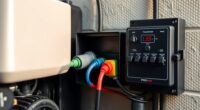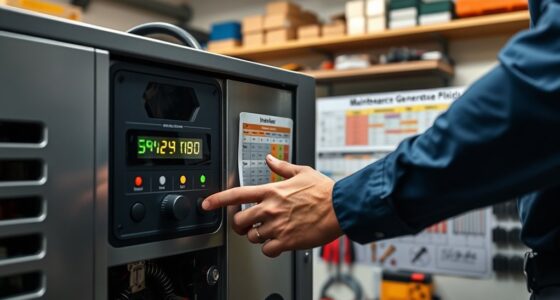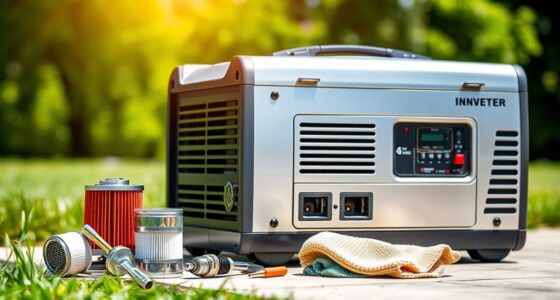Many believe spark plugs only need replacement when they fail, but worn plugs can harm ignition and fuel efficiency. The number of ground electrodes doesn’t always improve performance, and not all spark plugs are equal. Size and heat range matter more than you think, and platinum or iridium plugs won’t last forever. Mistakes about color, appearance, or using any plug that fits can lead to engine issues. Keep an eye out for these myths and learn more for better maintenance.
Key Takeaways
- Visual appearance alone doesn’t indicate spark plug health; proper diagnostics are essential.
- More electrodes don’t necessarily mean better performance; single ground electrodes are often more reliable.
- Worn spark plugs can impair engine performance and fuel efficiency even if they still look functional.
- Correct spark plug size and fit are more important than just length or thread diameter.
- Regular inspection and proper maintenance prevent misfires, engine damage, and costly repairs.
Spark Plugs Only Need Replacing When They Fail

Many people believe that you only need to replace spark plugs when they fail completely. However, worn spark plugs can affect ignition timing, leading to poor engine performance and lower fuel efficiency. The materials used in spark plugs, like copper, platinum, or iridium, influence how long they last and how well they maintain consistent sparks. Even if a spark plug looks fine, it may be causing misfires or inefficient combustion due to subtle wear or deposits. Regular inspection and replacement based on your vehicle’s maintenance schedule ensure ideal ignition timing and prevent performance issues. Additionally, spark plug technology has advanced to improve longevity and performance, making proactive replacement even more beneficial. Don’t wait for a complete failure—replacing spark plugs proactively keeps your engine running smoothly and helps avoid costly repairs down the line.
The Number of Ground Electrodes Significantly Affects Performance

The number of ground electrodes on your spark plug can directly impact how efficiently your engine runs. Multiple ground electrodes may improve spark arc consistency, but they can also influence fuel combustion and overall performance. Understanding this balance helps you choose the right spark plug for ideal engine function.
Ground Electrodes Count
The number of ground electrodes on a spark plug plays a crucial role in its performance. Many people believe that more electrodes equal better performance, but this is a ground electrode myths misconception. In reality, electrode count misconceptions can lead to misunderstandings about efficiency and longevity.
- Single ground electrode designs often provide reliable spark delivery with less fouling.
- Multiple ground electrodes may increase the risk of misfires or uneven wear.
- Fewer electrodes typically mean easier maintenance and more consistent performance.
- When selecting spark plugs, considering electric bike performance factors can help ensure optimal operation and longevity.
It’s important to remember that adding more ground electrodes doesn’t automatically improve spark quality. Instead, focus on the quality of materials and design, as these factors influence performance more than just electrode count. Don’t fall for ground electrode myths—know what truly impacts your spark plug’s efficiency.
Spark Arc Efficiency
While it might seem intuitive that adding more ground electrodes improves spark efficiency, the number of ground electrodes actually has a significant impact on how well the spark arc forms and sustains. Too many ground electrodes can disperse the spark, reducing its intensity and leading to lower spark arc efficiency. This dispersion makes it harder to maintain consistent ignition stability, especially under challenging conditions. Conversely, a single, well-designed ground electrode focuses the energy, creating a more concentrated and reliable spark. This enhances ignition stability and ensures the spark effectively ignites the fuel-air mixture. Ultimately, optimizing the number and design of ground electrodes helps maximize spark arc efficiency, resulting in better engine performance and more reliable starts.
Fuel Combustion Impact
Have you ever wondered how the number of ground electrodes influences fuel combustion? The ground electrodes play a vital role in combustion efficiency by affecting how well the spark ignites the fuel mixture. A spark plug with multiple ground electrodes can create overlapping spark paths, which may improve ignition reliability but can also reduce the intensity of the spark. This, in turn, impacts how completely the fuel burns.
- Fewer ground electrodes generally produce a hotter, more focused spark, enhancing combustion efficiency.
- Multiple electrodes might cause weaker sparks, leading to incomplete fuel ignition.
- The spark’s strength directly influences how effectively the fuel mixture is ignited, affecting overall engine performance.
- The ground electrode design and number are critical factors in optimizing engine performance and fuel efficiency.
Choosing the right number of ground electrodes guarantees ideal fuel combustion and better engine efficiency.
All Spark Plugs Are Created Equal
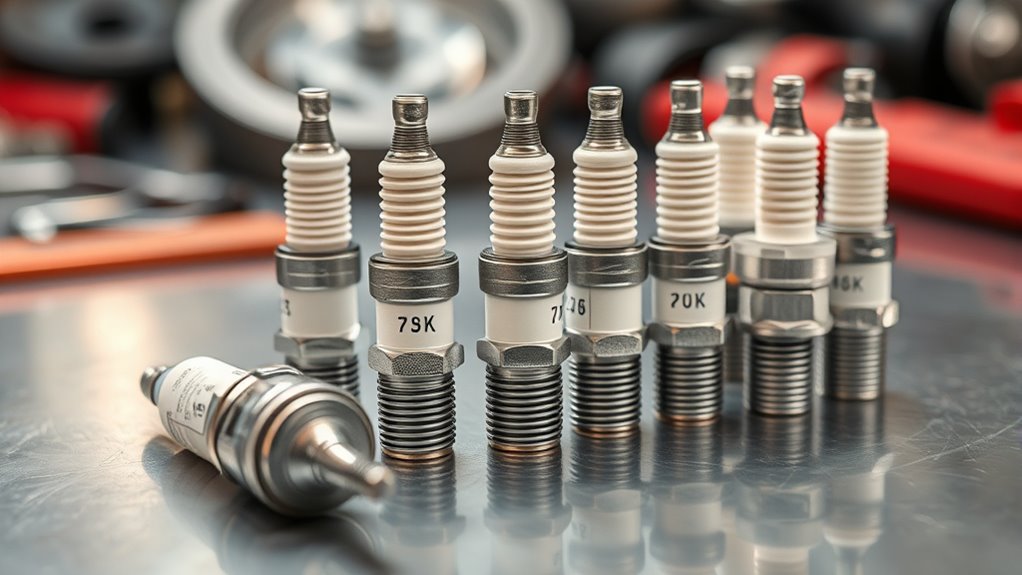
Not all spark plugs are the same, even if they look similar at first glance. Different spark plugs use various materials like copper, platinum, or iridium, which affect durability and performance. These materials influence how well the spark plug conducts electricity and withstands high temperatures, impacting ignition timing and overall engine efficiency. For example, platinum and iridium plugs last longer and provide more consistent sparks, improving fuel economy and reducing misfires. Conversely, cheaper copper plugs may need replacing more often and might not deliver the same performance. Additionally, the material composition of a spark plug plays a crucial role in its longevity and effectiveness. So, assuming all spark plugs are equal neglects key differences that can affect your engine’s power and longevity. Choosing the right spark plug depends on your vehicle’s specific requirements and the quality of spark plug materials used.
Spark Plug Size and Heat Range Are Not Critical

Many believe that spark plug size and heat range don’t matter, but that’s not entirely true. The right fit is essential for ideal performance, even if size seems flexible. Understanding how heat range affects your engine helps you make better choices for longevity and efficiency.
Size Doesn’t Affect Performance
While it might seem intuitive that the size of a spark plug impacts its performance, this isn’t actually the case. The spark plug size, including the length and thread diameter, doesn’t substantially influence how your engine runs. Instead, the performance impact comes from choosing the right heat range and electrode design.
Understanding this helps you avoid unnecessary worries about sizing. Focus on selecting a spark plug that fits your engine’s specifications and provides consistent spark.
Additionally, the correct heat range is vital for preventing fouling or overheating, which can significantly affect engine performance.
Remember:
- Larger spark plugs don’t necessarily produce a stronger spark
- Smaller spark plugs aren’t inherently faster
- Proper fit is more important than size for ideal performance
In short, spark plug size isn’t a critical factor in performance impact—proper fit and design matter more for your engine’s efficiency.
Heat Range Is Flexible
Choosing the right spark plug involves more than just size; the heat range plays a significant role in your engine’s performance. Many believe heat range is flexible, but in reality, it’s a critical factor for ideal spark plug adaptability. A proper heat range ensures the plug dissipates heat effectively, preventing fouling or pre-ignition. While some think you can swap heat ranges freely, mismatched ranges can harm your engine. Use the right heat range recommended by your manufacturer for best results. Here’s a quick overview:
| Heat Range | Function | Consequence of Mismatch |
|---|---|---|
| Hot | Retains heat, prevents fouling | Pre-ignition, knocking |
| Cold | Dissipates heat quickly | Fouling, sluggish performance |
| Moderate | Balanced performance | Ideal spark plug adaptability |
Additionally, understanding the heat transfer process helps in selecting the appropriate heat range for your specific engine conditions.
Proper Fit Is Key
Although spark plug size and heat range are often emphasized, they are not as critical to your engine’s performance as many believe. The key is guaranteeing proper fit and correct installation. When your spark plug fits properly, it maintains proper contact with the combustion chamber and prevents issues like misfires or damage. Proper fit also ensures ideal heat transfer and reliable ignition. Remember, the focus should be on choosing the right part for your engine, rather than obsessing over minor size differences. To get it right:
- Verify the spark plug’s thread size and reach before installation
- Use the correct torque to avoid over-tightening or under-tightening
- Confirm the heat range is suitable for your engine’s operating conditions
Proper fit and correct installation are what truly matter for engine health and performance.
Platinum and Iridium Spark Plugs Last Forever
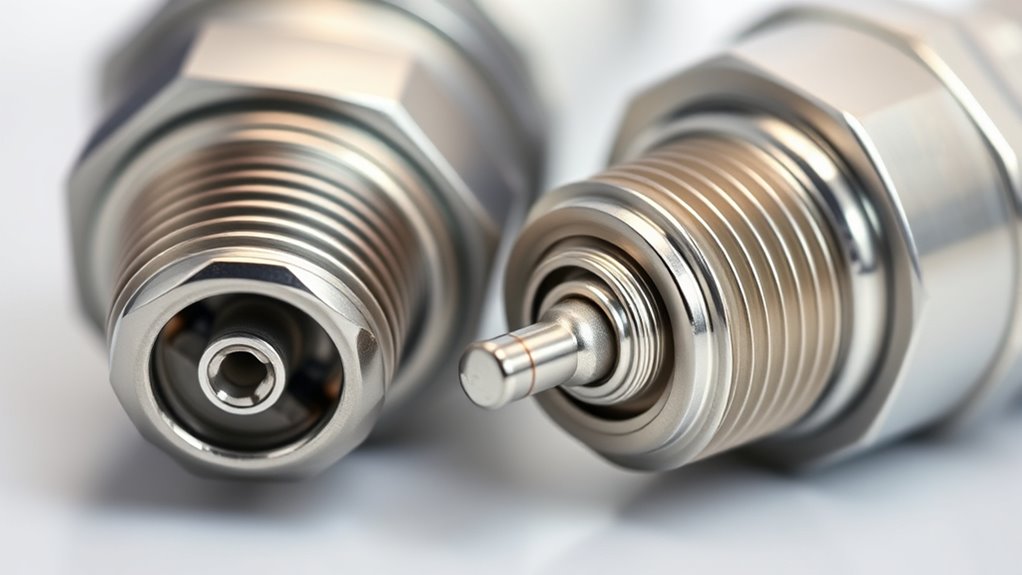
Many believe that platinum and iridium spark plugs last forever, but that’s not entirely true. While these spark plug materials are more durable due to their resistance to wear, they still require replacement over time. The electrode design and materials extend their lifespan, but they aren’t immune to degradation. Factors like engine conditions and maintenance influence their longevity. Regular inspections and understanding spark plug material properties can help optimize performance.
Using the Wrong Spark Plug Will Completely Ruin Your Engine
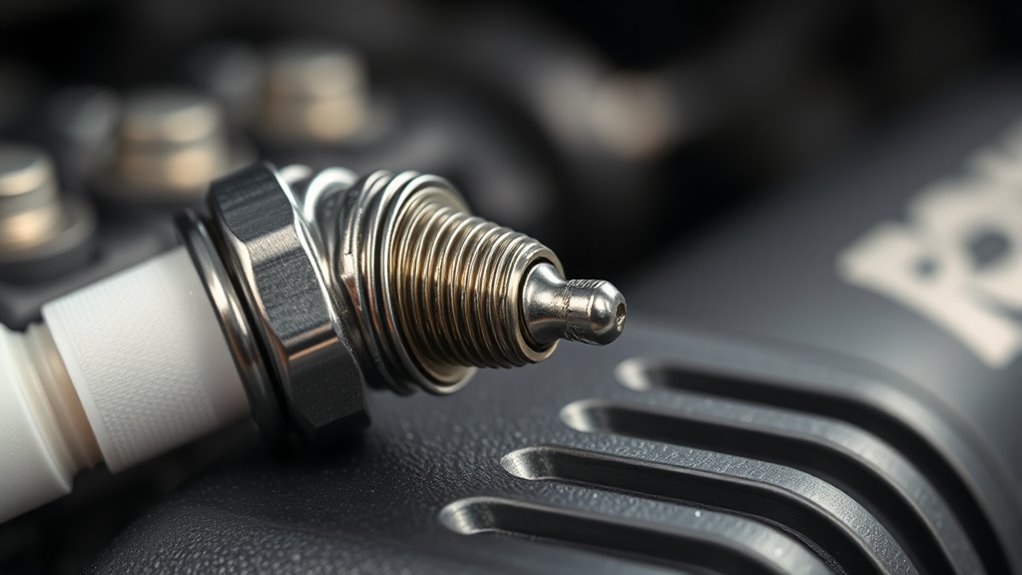
Using the wrong spark plug can lead to serious engine damage and costly repairs. It also causes performance issues like misfires, rough idling, and reduced fuel efficiency. Choosing the correct spark plug is essential to keep your engine running smoothly. Additionally, understanding engine component compatibility can help prevent mishaps caused by improper spark plug selection.
Engine Damage Risks
Choosing the wrong spark plug can considerably damage your engine, even if it seems like a simple mistake. Incorrect plugs can disrupt ignition timing, leading to misfires that strain engine components. Additionally, improper heat range can cause excessive carbon buildup, clogging combustion chambers and valves. This buildup hampers efficient combustion and accelerates wear. Risks include:
- Ignition timing issues that cause knocking or pinging
- Increased carbon deposits that clog the engine
- Overheating or fouling due to incompatible heat ranges
These problems can lead to uneven firing, piston damage, or even complete engine failure if ignored. Using the right spark plug is vital to prevent these risks and guarantee smooth, safe engine operation. Always match your spark plug with your engine’s specifications to avoid costly repairs.
Performance Issues Arise
Installing the wrong spark plug can severely compromise your engine’s performance, leading to noticeable issues such as poor acceleration, rough idling, and reduced fuel efficiency. When the spark plug’s heat range or materials don’t match your engine’s requirements, ignition timing can become inconsistent, causing misfires and power loss. Spark plug materials like copper, platinum, or iridium each have different durability and heat transfer qualities; using incompatible materials can result in poor combustion. Incorrect spark plugs can also delay or disrupt ignition timing, making your engine run inefficiently. As a result, you may experience hesitation, increased emissions, and higher fuel consumption. Choosing the correct spark plug with the appropriate engine specifications is essential to maintain smooth engine performance and prevent costly damage.
Spark Plug Gaps Are Fixed and Never Need Adjustment
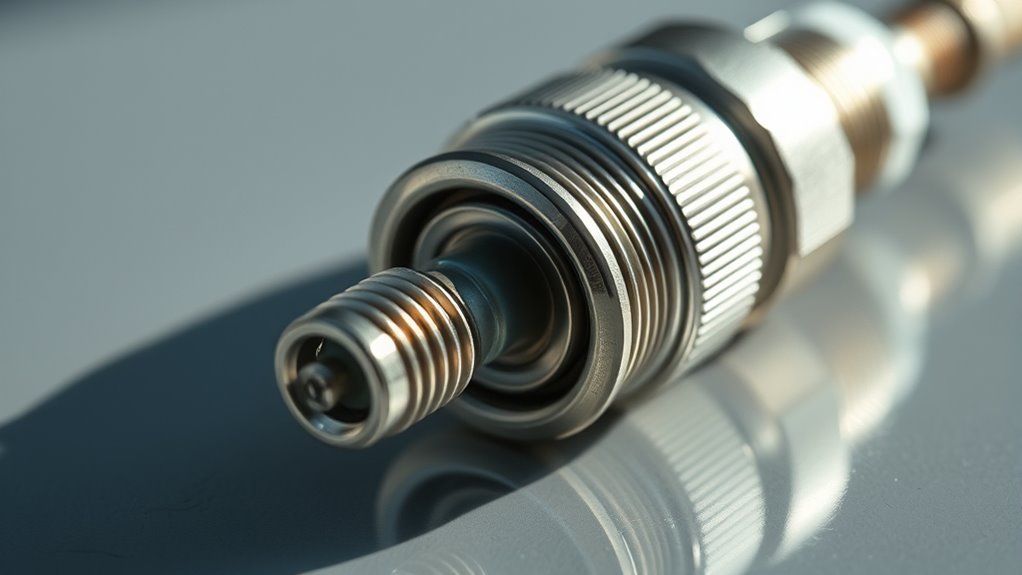
Many people assume that spark plug gaps are fixed and never need adjustment, but in reality, they often do. During spark plug manufacturing, electrode materials and design can cause slight variations in gap sizes. Over time, wear, vibrations, or thermal conditions can alter these gaps, affecting engine performance. Regularly checking and adjusting your spark plug gap ensures ideal ignition and fuel efficiency. Keep in mind:
- Gaps can widen due to electrode erosion, especially with certain materials.
- Hotter engine conditions might require different gap settings.
- Proper gap adjustment can prevent misfires and rough idling.
Always refer to your vehicle’s specifications and consider the effects of electrode materials when adjusting the gap. Neglecting this step can lead to reduced power, increased emissions, or engine damage. Don’t assume gaps stay the same—check them periodically.
Spark Plug Maintenance Is Only About Replacing Worn-Out Parts
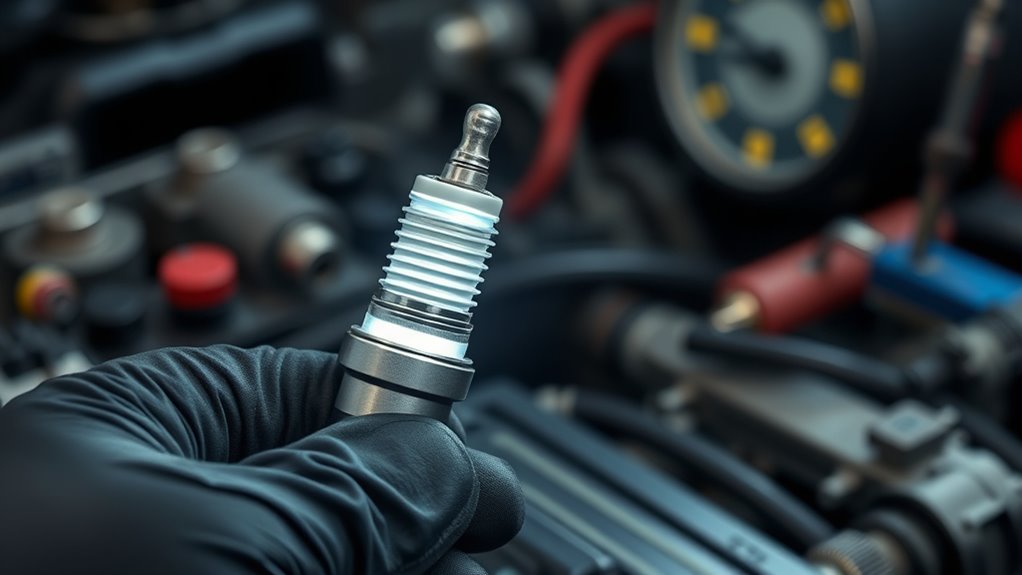
While replacing worn-out parts is a common aspect of spark plug maintenance, it’s only part of the story. Proper maintenance also involves inspecting the spark plug design and ensuring your ignition system is functioning at its best. A clean, properly gapped spark plug promotes efficient combustion and smooth engine performance. Neglecting these factors can cause misfires, poor acceleration, and increased emissions. Regularly check for carbon buildup, corrosion, and proper electrode condition. Understanding how your spark plug interacts with the ignition system helps you identify issues early. Here’s a quick overview:
| Maintenance Task | Why It Matters | Recommended Interval |
|---|---|---|
| Inspect spark plug design | Ensures ideal combustion and ignition | Every 30,000 miles |
| Check ignition system | Maintains spark consistency | During major tune-ups |
| Clean or replace electrodes | Prevents misfires | As needed |
| Gaps adjustment | Ensures proper spark delivery | During inspections |
| Monitor engine performance | Detects early signs of ignition issues | Regularly |
Spark Plugs Directly Influence Fuel Economy More Than Other Factors

Proper spark plug maintenance not only keeps your engine running smoothly but also plays a significant role in maximizing fuel efficiency. When spark plugs are clean and properly gapped, they ensure efficient combustion, directly impacting your vehicle’s fuel economy and engine performance. Poorly maintained spark plugs can cause misfires, reduced power, and higher fuel consumption.
Proper spark plug care boosts engine performance and fuel efficiency through efficient combustion.
To improve fuel efficiency, focus on:
- Ensuring spark plugs are in good condition and correctly gapped
- Using the right type of spark plug for your vehicle
- Addressing ignition issues promptly for ideal engine performance
Modern Vehicles Don’t Require Spark Plug Maintenance
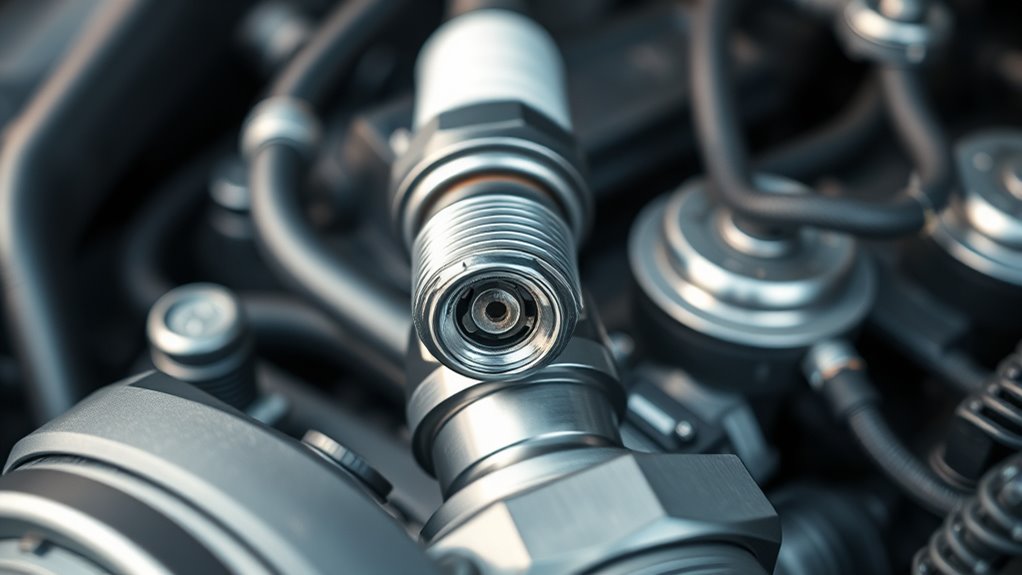
Advancements in automotive technology have led some to believe that modern vehicles no longer need spark plug maintenance. However, even with advanced ignition systems and fuel injection, spark plugs still play a crucial role. They ensure reliable engine starts, smooth operation, and optimal fuel combustion. Neglecting spark plug maintenance can cause misfires, reduced efficiency, and engine damage over time. Modern vehicles often have longer intervals between replacements, but regular inspection remains essential. Properly maintained spark plugs contribute to the vehicle’s overall performance and longevity.
| Aspect | Old Belief | Reality |
|---|---|---|
| Maintenance Needs | No maintenance required | Regular inspections improve performance |
| Ignition System | Less dependent on spark plug condition | Spark plugs still vital for ignition reliability |
| Fuel Injection | Eliminates need for spark plug care | Fuel injection reduces but doesn’t eliminate spark plug wear |
Spark Plug Color and Appearance Are the Best Indicators of Performance

Many car owners rely on the appearance of their spark plugs to gauge engine health, but color and physical condition alone don’t tell the full story about performance. While spark plug color can suggest certain issues, it’s not a definitive indicator of how well your engine runs. Look for appearance indicators like deposits, wear, or damage, but don’t assume they tell the whole story. For example:
- A light tan or gray spark plug usually indicates normal combustion.
- Black soot may suggest rich fuel mixture or oil burning.
- Excessive wear or deposits don’t always mean poor performance; other factors could be at play.
Relying solely on spark plug color can mislead you. Proper diagnostics require more than just visual cues—trust performance data and regular maintenance.
You Can Use Any Spark Plug With Your Vehicle as Long as It Fits
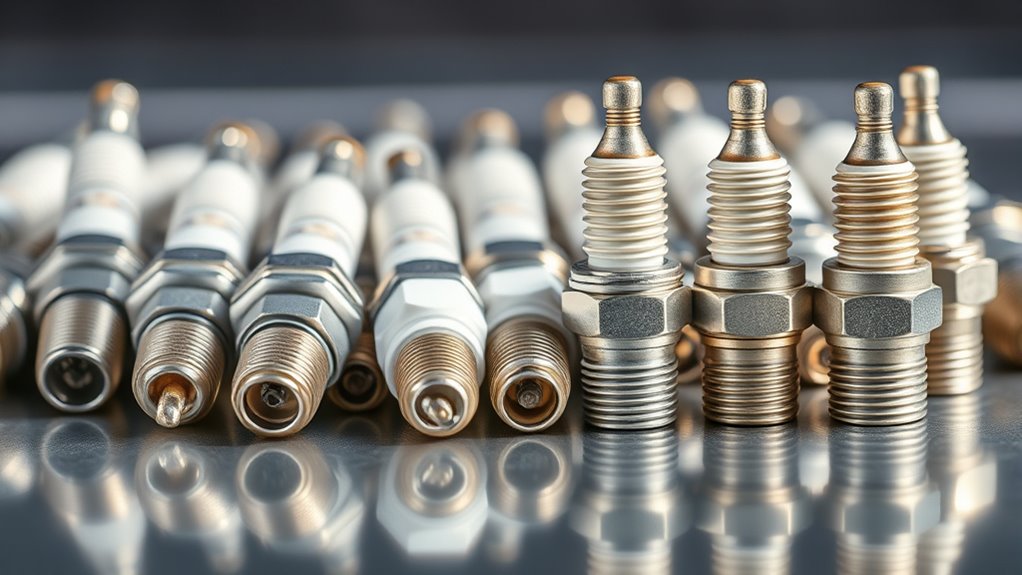
While it might seem convenient to swap in any spark plug that fits, not all plugs are suitable for your vehicle. Using the wrong spark plug can negatively impact spark plug longevity and engine performance. Fitment alone isn’t enough; you need to ensure the plug matches your engine’s specifications. Incorrect installation techniques can cause misfires or damage the spark plug and cylinder head. Always check the manufacturer’s recommendations for heat range, electrode design, and size before replacing a spark plug. A proper fit guarantees ideal performance and longevity. Remember, a correctly installed spark plug helps maintain efficient combustion, extends its lifespan, and prevents unnecessary repairs. Don’t assume any plug that fits will work well—selecting the right spark plug for your vehicle is essential for reliable operation.
Frequently Asked Questions
How Often Should I Inspect My Spark Plugs for Optimal Performance?
You should inspect your spark plugs every 30,000 miles or as part of your vehicle’s regular inspection schedule. During inspections, check for wear, carbon buildup, or damage to guarantee peak performance. Performance monitoring involves observing engine smoothness, fuel efficiency, and starting ease. Regular inspections help catch issues early, prevent misfires, and maintain engine efficiency, so stick to your vehicle’s recommended inspection schedule for the best results.
Can Aftermarket Spark Plugs Improve My Vehicle’s Acceleration?
You’ll be surprised to learn that aftermarket spark plugs can boost your vehicle’s acceleration by up to 10%. They often feature advanced materials and designs that improve combustion efficiency, leading to smoother and quicker throttle response. With aftermarket benefits like better ignition, you’ll notice faster acceleration and potentially increased fuel economy. If you want to enhance your driving experience, upgrading to quality aftermarket spark plugs is a smart choice for noticeable performance gains.
What Signs Indicate My Spark Plugs Need Immediate Replacement?
If your vehicle stalls, hesitates during acceleration, or you notice a rough idle, your spark plugs likely need immediate replacement. Look for misfire symptoms like engine jerks or poor fuel economy, which often result from spark plug damage. Addressing these signs promptly prevents further engine issues, ensuring your vehicle runs smoothly. Regularly inspect your spark plugs to catch problems early and maintain excellent performance.
Are There Specific Spark Plug Types Recommended for High-Performance Engines?
For high-performance engines, you should choose spark plugs with advanced spark plug alloys like platinum or iridium. Iridium plugs typically last longer and provide better ignitability, making them ideal for high-stress conditions. Platinum offers good performance at a more affordable price. Your choice depends on your engine’s demands and your budget, but generally, iridium spark plugs deliver superior durability and performance for high-performance applications.
How Does Engine Temperature Influence Spark Plug Selection?
Engine temperature plays a vital role in spark plug selection because it affects how well your engine cools. Cooler engines need hotter spark plugs to prevent fouling, while hotter engines require colder plugs to avoid knocking. Use engine cooling data and temperature sensors to choose the right spark plug heat range. Proper matching ensures efficient combustion, prevents misfires, and maintains ideal engine performance under varying temperature conditions.
Conclusion
Now that you know the truths behind spark plug myths, you’re better equipped to choose and maintain the right ones for your vehicle. Don’t fall for misconceptions that could hurt your engine’s performance or longevity. Remember, not all spark plugs are created equal, and proper care makes a difference. So, next time you think about replacing or inspecting your spark plugs, ask yourself: are you making informed decisions or just going with the crowd?

